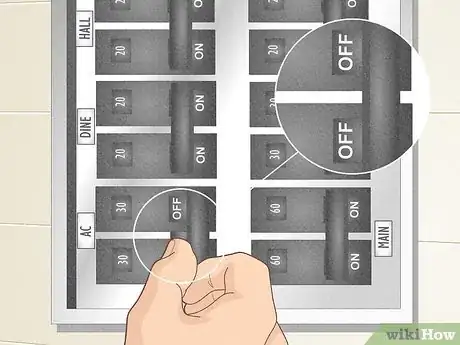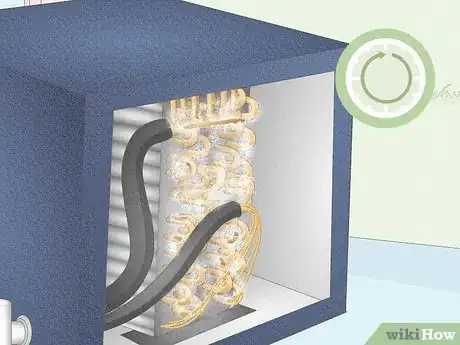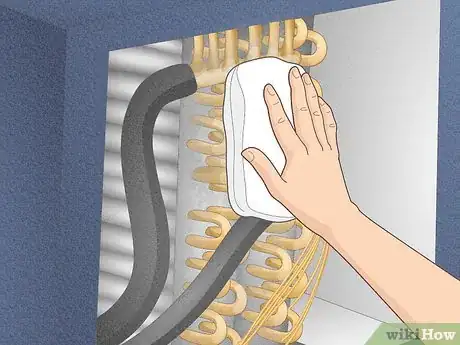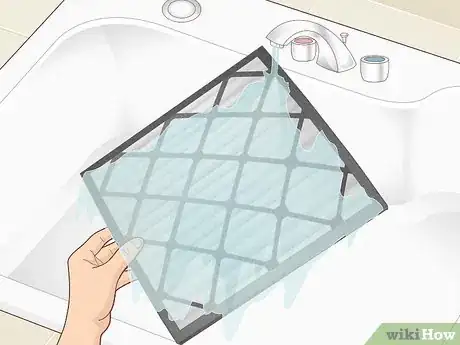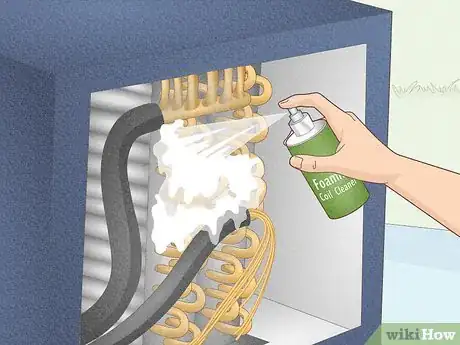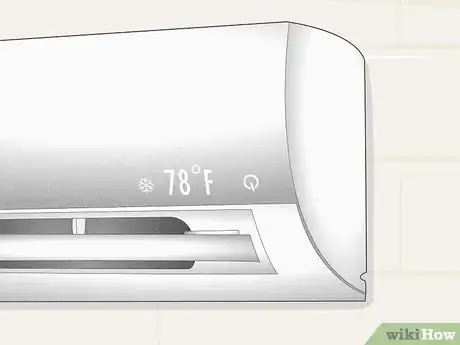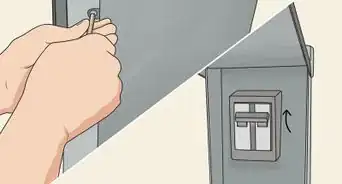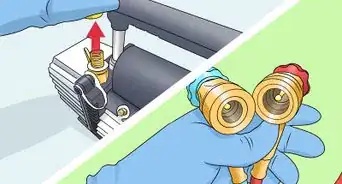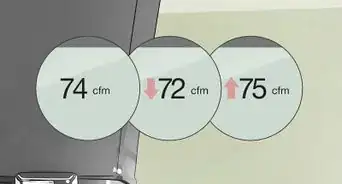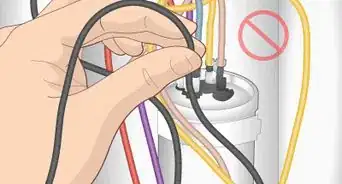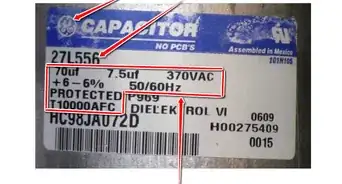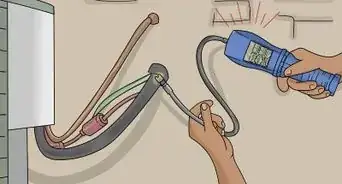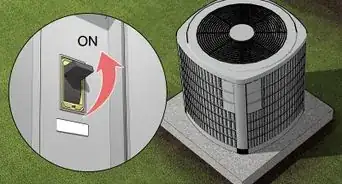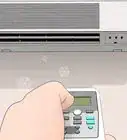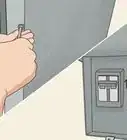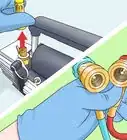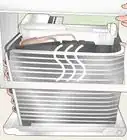This article was co-authored by Victor Belavus. Victor Belavus is an Air Conditioning Specialist and the Owner of 212 HVAC, an air condition repair and installation company based in Brooklyn, New York. In addition to HVAC and air conditioning units, Victor also specializes in furnace repair and air duct cleaning. He has over 10 years of experience working with HVAC systems.
This article has been viewed 9,213 times.
When you’re using your central AC system a lot and running it at especially cold temperatures, the moisture that accumulates on it can freeze and cause it to stop working properly. This can happen even during the hottest spells of summer weather — the time when you need that cool air the most! Take a few easy steps immediately to defrost your central air conditioner in order to keep your home nice and cool.
Steps
De-icing the Unit
-
1Turn the AC unit completely off as soon as you notice signs of frost. Locate the power switches on the thermostat and near the condensing unit outside and switch them off. Go to your home’s breaker box and flip the breakers that control the cooling system off to be extra sure it doesn’t turn on while you thaw it out.[1]
- Signs of frost include visible ice crystals on the unit and/or warm air blowing out of the unit.
- If you leave your AC unit running when it’s frosty, the problem can get worse and your unit could require costly repairs to fix.
- If the breaker that controls your AC system also controls other things that you don’t want to turn off, it’s okay to leave the breaker on. Turning it off is just an extra precaution.
- In the meantime, use fans or a portable AC unit to keep your home cool if you can’t bear the heat.
-
2Let the air conditioner thaw out for at least 24 hours. Minor frost might melt in as little as a few hours, but more serious frost typically takes up to a full day to thaw completely. Wait at least a day or more to be on the safe side and make sure that all the ice is gone.[2]
- Check the AC unit’s coils to make sure that there are no visible ice coils on them before proceeding.
- If you want to speed up the melting process, blast the unit with warm air from a blow dryer on the LOW setting only.
- Don’t pour hot water onto an AC unit to try and melt the frost. It is an electrical system and can get damaged this way.
Advertisement -
3Wipe water and condensation up from the AC unit with a towel. Inspect your air conditioner for pooled water and condensation. Soak any puddles and droplets up completely with a dry towel to remove excess moisture.[3]
- Accumulations of moisture are what freeze when you run your AC at cold temperatures for long periods of time, so that’s why it’s important to soak up all the excess moisture before you use the system again.
-
4Turn the AC system back on. Flip the breakers that control the system back on at your breaker box. Turn the power switch near the outdoor condenser unit back on, then turn the thermostat back on and set it to the temperature you want.[4]
- If the problem of your AC unit frosting over repeats itself, try some of the techniques from the frost prevention method below to see if they solve the problem.
Frost Prevention
-
1Clean the air conditioner’s filter. Turn off your air conditioner. Loosen the fasteners that hold the grille to the front of the blower unit inside your home and remove the grille. Pull out the filter and vacuum it if there is just a light layer of dust on it, or rinse it off and let it dry if there is caked-on dirt and grime.[5]
- Dirty air filters cause the system’s coils to get dirty, which can lead to freezing.
- If the filter is very dirty, it's best to just replace it.
-
2Clean the air conditioner coils. Turn off the AC unit. Unscrew the access panel at the back of the condenser and remove it. Spray a commercial coil cleaner onto all the copper coil tubes, wait the amount of time specified on the packaging, and wipe it off with a clean rag to remove dirt and grime from the coils.[6]
- When the coils get dirty, they get too cold and moisture that accumulates on them freezes over.
- You could spray off the coils with a hose or use condenser cleaning acid. If you use acid, wear protective gear like goggles and gloves and mix the acid with water according to the instructions on the package.
-
3Check the condensate drain line for clogs and clean it if necessary. Look for the white PVC or copper tubing near the outdoor condenser unit. Inspect this condensate drain line for any visible materials clogging it, such as leaves or other debris. Look for pools of water and condensation buildups in the system as well, which can also be signs of clogs.[7]
- If you notice that the drain line is clogged, pour 1/4 cup (59 mL) of distilled white vinegar into the T-shaped access pipe on the drain line. Wait 30 minutes, then flush the drain line out with water to clear clogs.
- Alternatively, use a CO2 gun and AC drain brush to clear the clogs.
-
4Call an HVAC technician to check the refrigerant and recharge it if needed. Low levels of freon, the coolant used in AC units, can be a cause of frost problems. Refilling freon is dangerous and you need an EPA certification to do so, so always have a professional recharge your AC unit and never attempt to do it yourself.
- An HVAC technician will also be able to inspect your system for refrigerant leaks and repair them if they find any.
-
5Run your AC unit at no lower than 78 °F (26 °C). This is the optimal temperature to set your thermostat to. It keeps your home cool when it’s hot outside without being so cold that it causes the unit to freeze over.[8]
- When you’re asleep, run the AC at 82 °F (28 °C) to save energy. When you’re away, don’t set it any lower than 85 °F (29 °C).
Warnings
- Don’t pour hot water on an AC unit to try and defrost it. Water can damage electrical components.⧼thumbs_response⧽
- Never attempt to recharge your air conditioner’s freon yourself. It is dangerous and should only be done by a professional.⧼thumbs_response⧽
References
- ↑ https://www.hvac.com/blog/how-to-de-ice-an-air-conditioning-unit/
- ↑ https://www.hvac.com/blog/how-to-de-ice-an-air-conditioning-unit/
- ↑ https://www.hvac.com/blog/how-to-de-ice-an-air-conditioning-unit/
- ↑ http://wesellpolkcounty.com/2016/07/13/how-to-defrost-your-frozen-ac-unit-and-keep-it-from-freezing-again/
- ↑ http://wesellpolkcounty.com/2016/07/13/how-to-defrost-your-frozen-ac-unit-and-keep-it-from-freezing-again/
- ↑ http://wesellpolkcounty.com/2016/07/13/how-to-defrost-your-frozen-ac-unit-and-keep-it-from-freezing-again/
- ↑ https://www.energy.gov/energysaver/common-air-conditioner-problems
- ↑ https://www.consumerreports.org/central-air-conditioners/best-setting-for-central-air-conditioning/
- ↑ https://www.hvac.com/blog/how-to-de-ice-an-air-conditioning-unit/
